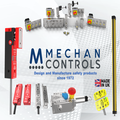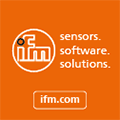
Posted to News on 29th Aug 2016, 11:39
Intelligent rotary encoders help implement Industry 4.0
Jeff Smoot, VP of application engineering and motion control at CUI, discusses how intelligent rotary encoders can help machine builders implement Industry 4.0 principles.

Industry 4.0 is a term coined to describe the fourth industrial revolution, a brave new world where factory automation moves beyond manufacturing plants controlled by conventional information technology systems to a cloud-based infrastructure that permits big data analytics and the virtualisation of production processes. This vision is much more than just an Industrial Internet of Things (IIoT) and yet, while it may have ambitions to facilitate intelligence through cognitive behaviour such as self-configuration and autonomous optimisation, the founding principle of any control system involves feedback that depends on sensing its own condition and the environment around it.
Motion control is vital in ensuring the correct operation of industrial machinery, whether it is the motors that drive conveyor belts or the robotic arms that assemble components. Here the increasing number of applications that demand precision control has seen a rise in the use of rotary encoders to determine the position of motor shafts and their rotational direction, velocity and acceleration. Reliability is clearly important in a manufacturing environment and the choice of encoder technology can be key (see below).
However, another facet of reliability is the very real cost of downtime due to machine failure and the time taken to repair and restart a production line. Anything that can help to anticipate impending failure and/or minimise the time needed to diagnose and remedy a fault has to be welcome. Industry 4.0 envisages flexible manufacturing systems that may entail the frequent reconfiguration of equipment. This, in turn, requires intelligent sensors, whose digital nature not only provides diagnostic data but also facilitates simple and quick setup, thereby helping save time and cost.
Encoder outputs - positional signals and intelligent data
All rotary incremental encoders provide the standard digital outputs of A and B quadrature signals plus, in some instances, an index signal. For commutation encoders, U, V and W commutation-phase channel outputs are included along with the A, B, and Index signals of an incremental encoder. These standard outputs provide valuable feedback to the motion control system but, in effect, are simply operating as a 'dumb' sensor. However, an ASIC-based encoder design enables additional digital control features to be built in, including valuable diagnostic capabilities that were not previously possible with pure analogue systems. Such data can confirm that the encoder is operating correctly or if it has developed a fault or become misaligned. While this information might be used to inform operators of potential issues, it could also be used more autonomously by the system to prevent a motor being switched on, avoiding potentially serious damage. Engineers can also incorporate this feature into the power-on sequence for a system or in preventative maintenance programs, executing an 'encoder good' test sequence before turning on the motor. These measures can help eliminate potential failures and the consequential issue of machine downtime.
Because the encoder is mounted directly on the motor, diagnostic information may reveal wider issues within the motor control system, such as shaft misalignment, bearing wear or thermal degradation. Routine logging of this data can provide a valuable database that can be examined to reveal useful performance trends that may even predict a failure before it happens. Analysis could flag the need for maintenance to remedy an impending problem before a catastrophic failure occurs, further limiting the impact of crippling downtime and contributing to system reliability and extending equipment lifetime. Within a networked factory automation environment the ability to share this data and its analysis contributes to the overall system intelligence that Industry 4.0 is looking for.
Quicker troubleshooting, faster development
Apart from potentially predicting failure, on-board diagnostics facilitate more rapid troubleshooting should a failure occur in the field. A repair technician can easily query the encoder with a diagnostic routine to determine if the encoder is working properly or if the failure is perhaps due to a mechanical misalignment with the motor shaft or some other cause. If the encoder is not at fault, it can be ruled out so the technician can look elsewhere for the source of the problem. This capability can eliminate the needless, time-consuming and expensive trial-and-error process of alternately removing and replacing the encoder and motor. Furthermore, should the encoder prove to be faulty and need to be replaced, the process of aligning and zeroing a digitally-controlled encoder using a simple programming interface will only take a matter of seconds compared to the time required to complete this task with a conventional non-programmable encoder. While a field failure is inevitably an inconvenient and expensive interruption to manufacturing operations, the ability to identify a fault quickly and carry out the repair clearly minimises downtime and reduces those costs.
The same digital control and diagnostic capabilities that contribute to increased system reliability and the more rapid resolution of any problems can also significantly shorten system development cycles. The nature of complex designs unfortunately means that the 'right first time' philosophy is not always realised. Facing the challenge of determining why something is not quite working as expected becomes much easier with the ability to access diagnostic information that can quickly point to the problem and potentially eliminate days or weeks of investigation. This will not only save development cost but can result in a more robust system and achieve a faster time to market.

Industry 4.0 may be a vision of the future for industrial automation and enterprise-wide information sharing and control, but an essential first step along this path is the deployment of intelligent sensing and control devices such as the AMT encoder that provides vital diagnostic information to the system. While the availability of such data will not completely eliminate machine failures and system downtime, it should help reduce the incidence of problems and improve the speed of recovery.
Selecting a reliable encoder technology
The best-known rotary encoder technologies are optical and magnetic. Optical designs use a slotted disk with an LED on one side and phototransistors on the opposite side. As the disk rotates, the light path is interrupted and the resultant pulses indicate shaft rotation and direction. Although low cost and effective, the reliability of optical encoders can be affected by dirt, dust and grease that interfere with the light path, added to which the brightness of the LEDs will also reduce over time.
Magnetic encoders depend on a magnetic field rather than a beam of light, using a magnetised disk that spins over an array of magneto-resistive sensors. While offering a high level of durability, the magnetic encoder is not as accurate as an optical encoder and is susceptible to magnetic interference from the electric motor.
Capacitive encoding is an alternative approach that offers the benefits of optical and magnetic encoder designs without their weaknesses. This technique uses two patterns of bars or lines, one on a fixed element and the other on a moving element, to form a variable capacitor. As the encoder rotates the line changes are counted and also interpolated to find the position of the shaft and direction of rotation. The advantage of this capacitive technology is that there is nothing to wear out and it is immune to contaminants, making it inherently more reliable than optical devices. Capacitive encoders also offer performance advantages derived from their digital control features, including the ability to adjust the encoder's resolution (pulses per revolution) without the need to change to a higher- or lower-resolution encoder.
Follow the link for more information about intelligent rotary encoders from CUI.
Want the latest machine building news straight to your inbox? Become a MachineBuilding member for free today >>















